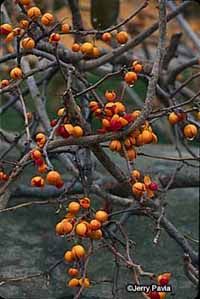American bittersweet, a climbing shrub, is native to North America east of the Rocky Mountains. It is an extremely rampant grower and care should be taken not to let it escape into desirable trees or shrubs.
: This woody shrub climbs by twining around its support and is so efficient that it frequently strangles the trees it grows on. It can grow to whatever height its host attains. The stems are woody. Its deep green, glossy leaves are ovate and pointed, turning yellow before dropping in the fall. The male and female flowers, inconspicuous, appear on separate plants. If pollinated, female flowers bear striking orange berries in the fall, lasting through much of the winter.
Advertisement
: This plant will thrive hi nearly any soil that is not constantly wet. It requires full sun or partial shade to get started. Make sure to plant at least one male per group of three females to ensure pollination. Prune severely in early spring to stimulate flowering and also cut off unwanted suckers.
: American bittersweet is often used to cover unsightly fences and rock piles. It can be trained up arbors, trellises, and even mature trees, but should never be allowed to climb young trees or shrubs because the vine's twisting woody stems can cut off their sap as they grow. The seeds, although poisonous to humans, seem to do no harm to the birds that eat them in winter. The fruit-bearing branches are often harvested for dried winter decorations.
American bittersweet related species: The Loesener bittersweet (Celastrus Loeseneri or, more correctly, C. Rosthornianus) is similar, but less hardy and not as attractive. Asian bittersweet (C. Orbiculatus) is an invasive weed and should not be planted.
: Celastrus scandens
Advertisement
